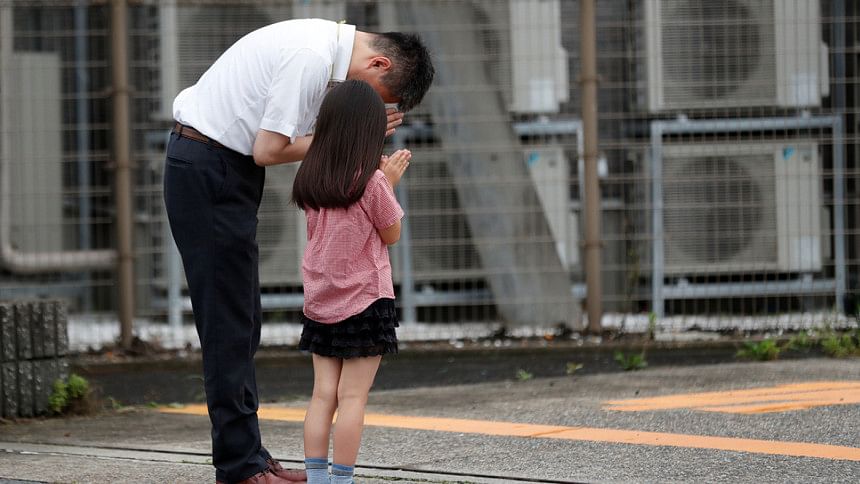"I don't have words": Boss of torched Japan animation studio mourns bright, young staff

-- Death toll at Kyoto Animation studio climbs to 34
-- Names of victims not yet disclosed for definitive identification
-- "Anime" fans and local residents pay tribute
Many victims of an arson attack on a Japanese animation studio were young with bright futures, some joining only in April, the shaken company president said on Saturday, as the death toll climbed to 34.
Thursday's attack on Kyoto Animation, well known for its television series and movies, was Japan's worst mass killing in two decades. It was all the more poignant because of the youth of the victims in a country where the population is among the world's oldest.
Many of the victims of the attack, in the ancient capital of Kyoto, were young women, company president Hideaki Hatta said.
"Some of them joined us just in April. And on the eighth of July, I gave them a small, but their first, bonus," he said.
"People who had a promising future lost their lives. I don't know what to say. Rather than feeling anger, I just don't have words," Hatta said.
Fifteen of the victims were in their 20s and 11 were in their 30s, public broadcaster NHK said. Six were in their 40s and one was at least 60. The age of the latest victim, a man who died in hospital, was not known.
The names of the victims have not been disclosed yet to wait for definitive identification.
Police have confirmed the identity of the suspect as Shinji Aoba, ex-convict of a shop robbery, but have not formally arrested him as he is being treated for heavy burns.
It is unusual for the police to release a suspect's name before making an arrest.
PLAGIARISM CLAIM
Aoba lives in a modest, two-floor apartment building 500 km (310 miles) from Kyoto in a rural suburb just outside Omiya, a commuter hub north of Tokyo.
A 27-year-old neighbour said Aoba had once grabbed him and yelled at him over a noise dispute.
"He started yelling at me to my face to shut up. He grabbed me by the collar and started pulling my hair. It was terrifying," the neighbour, who declined to be identified, said.
Aoba is suspected of carrying out the arson attack because he believed his novel had been plagiarized, local media says.
But Hatta said he had no idea about any plagiarism claim, adding he had not seen any correspondence from the suspect.
People living near the studio said they saw a man fitting Aoba's description in a park the day before the attack. Police suspect he may have spent a day or more in the area to prepare.
Resident Rie Bannai said her nephew saw the man sleeping on a bench in the park.
Rui Yamaguchi, who works in a factory nearby, said he saw the suspect when he was detained.
"He looked like a mannequin with no hair and blackened. One of his pants legs had gone around his calf. It looked like it had burnt off," he said.
'BEAUTIFUL AND WARM'
Near the blackened studio building, where the smell of burning timber lingered over the neighbourhood, animation fans from many nationalities and local residents queued up to add to a growing pile of flowers, drinks and other offerings.
Bing Xie, 25, a Chinese student at Kyoto University, said she could not forgive the arsonist.
"The criminal who does this seems to have been mentally disturbed, but I can't forgive him. The young people at Kyoto Animation were beautiful and warm and it is hard to accept they are gone."
Police guarded the site as investigators, some on the roof near where many died in a connecting stairwell, examined the torched three-story building.
Hatta said the building needed to be torn down because it was so badly damaged.
Tributes to the victims lit up social media, with world leaders and Apple Inc's chief executive offering condolences. The hashtag #PrayforKyoAni, as the studio is known among fans, has become popular.
Kyoto Animation produces popular "anime" series such as the "Sound! Euphonium". It is also known for "Violet Evergarden", which has been shown on Netflix.
Fumiko Shimizu, 91, who lives close to the building and watched the fire from her balcony at home, said she regularly greeted the staff she met in the street.
"I used to see them going to the convenience store in groups of six or so to buy lunch boxes. There were a lot of young people, in the twenties and thirties. They died so young when it would be alright for somebody like me to die anytime," she said.

 For all latest news, follow The Daily Star's Google News channel.
For all latest news, follow The Daily Star's Google News channel. 



Comments